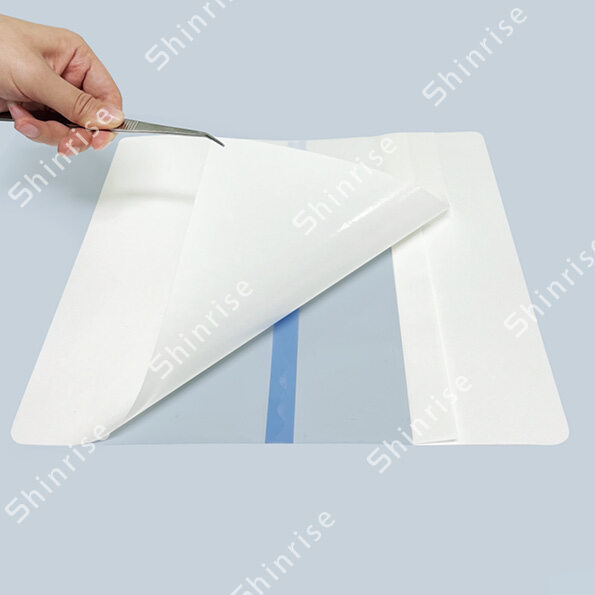Email cannot be empty
Password cannot be empty
Email format error
Email cannot be empty
Email already exists
6-20 characters(letters plus numbers only)
The password is inconsistent
Email format error
Email cannot be empty
Email does not exist
6-20 characters(letters plus numbers only)
The password is inconsistent


The Benefits and Use of Calcium Alginate Wound Dressings: A Comprehensive Guide
When it comes to wound care, modern medicine has developed a wide range of dressing materials designed to accelerate healing and improve comfort. One type of dressing that has gained significant popularity is calcium alginate wound dressings. These dressings offer unique advantages, making them suitable for a variety of wounds, from chronic ulcers to post-surgical incisions. In this blog, we'll dive deep into the world of calcium alginate wound dressings, exploring how they work, their benefits, and their applications in wound care.
What is Calcium Alginate?
Before we delve into the specifics of wound dressings, it's essential to understand what calcium alginate actually is. Calcium alginate is a natural product derived from seaweed, specifically brown algae. This marine-based product is rich in a substance called alginic acid, which has impressive absorbent properties. When combined with calcium ions, alginic acid forms calcium alginate, a fibrous material that can absorb a significant amount of liquid, making it perfect for managing wounds that produce excess fluid.
Now, you may wonder: what makes seaweed such an excellent material for wound dressings? The answer lies in its natural ability to trap moisture, making it ideal for handling wet or heavily exuding wounds. This moisture management is key to accelerating healing and preventing infection.
How Calcium Alginate Wound Dressings Work
One of the standout features of calcium alginate wound dressings is their remarkable absorbency. When placed on a wound, the calcium alginate fibers interact with wound exudate (the fluid that comes from the wound), and in doing so, the calcium ions in the alginate exchange places with sodium ions found in the wound fluid. This exchange creates a gel-like substance that not only absorbs excess moisture but also helps maintain a moist environment, which is crucial for optimal wound healing.
The Healing Power of Moisture
You might think keeping a wound dry would help it heal faster, but this is actually a common misconception. Research shows that maintaining a moist wound environment helps tissues regenerate more quickly and reduces the risk of infection. A moist environment allows new skin cells to migrate across the wound bed more easily, speeding up the overall healing process.
Calcium alginate wound dressings excel at this because they absorb exudate without drying out the wound bed. By transforming into a gel, these dressings keep the wound surface hydrated while simultaneously absorbing and controlling excess moisture. This dual action minimizes maceration (when the skin around the wound becomes too wet and breaks down), further promoting healing.
Key Benefits of Calcium Alginate Wound Dressings
Now that we understand the basics of how calcium alginate wound dressings work, let's take a closer look at some of their key benefits. These dressings offer a range of advantages for both patients and healthcare providers:
1. High Absorption Capacity
One of the most important features of calcium alginate dressings is their ability to absorb a large amount of exudate. This makes them ideal for managing wounds that produce a lot of fluid, such as venous leg ulcers, pressure ulcers, or surgical wounds. By effectively managing wound exudate, calcium alginate dressings help reduce the risk of complications like infection or maceration.
2. Moist Wound Healing Environment
As mentioned earlier, a moist environment is crucial for wound healing. Calcium alginate dressings maintain this balance by turning into a gel when they come into contact with wound fluid. This gel formation helps create an ideal healing environment that encourages faster cell growth and tissue regeneration, ultimately speeding up the recovery process.
3. Pain-Free Removal
Unlike some traditional wound dressings, which can adhere to the wound bed and cause pain during removal, calcium alginate dressings are designed to be non-adherent. Because they form a soft, gel-like substance over the wound, they can be removed without causing trauma to the healing tissue. This reduces pain and discomfort for patients, particularly those with sensitive or fragile skin.
4. Antibacterial Properties
Some calcium alginate dressings are impregnated with silver, which has natural antimicrobial properties. Silver ions can help kill bacteria in and around the wound, reducing the risk of infection. These silver-infused calcium alginate dressings are particularly useful for wounds at high risk of becoming infected, such as diabetic foot ulcers or pressure ulcers.
5. Flexible and Easy to Apply
Calcium alginate wound dressings come in various forms, including sheets, ropes, and pads, making them adaptable to different wound types and shapes. For example, rope-shaped dressings are excellent for packing deep or tunneling wounds, while sheet dressings can cover larger, shallow wounds. This flexibility makes them an easy choice for healthcare providers, as they can be tailored to the specific needs of the patient.
6. Promoting Autolytic Debridement
Autolytic debridement is the process by which the body naturally breaks down dead or damaged tissue, allowing healthy tissue to thrive. Calcium alginate dressings support this process by creating a moist environment that softens and liquefies necrotic (dead) tissue. This not only accelerates wound healing but also reduces the need for more invasive debridement techniques, which can be painful and disruptive to the patient’s recovery.
Common Uses of Calcium Alginate Wound Dressings
Because of their absorbent properties and ability to promote moist wound healing, calcium alginate wound dressings are particularly useful for certain types of wounds. Let’s take a look at some of the most common scenarios in which these dressings are used:
1. Chronic Wounds
Chronic wounds, such as venous leg ulcers, diabetic foot ulcers, and pressure ulcers, are often slow to heal and require careful management. These wounds typically produce a lot of exudate, making calcium alginate dressings an ideal solution for controlling moisture while supporting healing. The dressings help manage the fluid, reduce the risk of infection, and keep the wound environment moist to encourage faster recovery.
2. Surgical Wounds
Post-surgical wounds are another area where calcium alginate dressings are highly effective. After surgery, wounds can produce significant exudate, particularly in the early stages of healing. Calcium alginate dressings help absorb this fluid, keeping the wound site clean and reducing the need for frequent dressing changes. Additionally, their non-adherent properties make them a comfortable option for patients recovering from surgery, as they can be removed without causing damage to the healing tissue.
3. Burns
Burn wounds, especially those that are partial-thickness, can benefit greatly from calcium alginate dressings. Burns often exude large amounts of fluid and require a dressing that can manage moisture without sticking to the delicate, healing skin. Calcium alginate dressings provide the right balance of absorption and protection, helping to minimize pain during dressing changes and supporting the healing process.
4. Infected Wounds
Wounds that show signs of infection, or that are at high risk of becoming infected, can also be treated with silver-impregnated calcium alginate dressings. The antimicrobial properties of silver help fight off bacteria, reducing the likelihood of infection and promoting a cleaner healing environment. These dressings are often used in cases of diabetic ulcers or pressure ulcers, where the risk of infection is high.
How to Use Calcium Alginate Wound Dressings
While healthcare providers typically apply and change wound dressings, it’s helpful for patients and caregivers to understand how to properly use calcium alginate wound dressings. Here’s a general guide to their application:
Clean the wound: Before applying the dressing, gently clean the wound with a sterile saline solution to remove any debris or dead tissue.
Choose the right dressing size: Calcium alginate dressings come in various shapes and sizes. Select the appropriate size based on the wound’s depth and shape. For deep wounds, consider using a rope-style dressing, while larger, shallow wounds may require a sheet or pad.
Apply the dressing: Place the calcium alginate dressing directly on the wound. Ensure that it covers the entire wound bed. If the wound is deep, lightly pack the dressing into the cavity, being careful not to over-pack.
Secure the dressing: Once the dressing is in place, secure it with a secondary dressing, such as a gauze pad or adhesive bandage, to keep it from shifting.
Change the dressing regularly: Depending on the amount of exudate, calcium alginate dressings may need to be changed every 1-3 days. If the dressing becomes saturated with fluid, or if there are signs of infection, change it sooner.
Conclusion
Calcium alginate wound dressings represent a significant advancement in wound care. Their ability to absorb large amounts of exudate, maintain a moist healing environment, and reduce pain during dressing changes makes them an excellent choice for a variety of wounds, from chronic ulcers to post-surgical sites. Additionally, their flexibility and ease of use mean that both healthcare providers and patients can benefit from their application. Whether you're managing a minor burn or caring for a more complex wound, calcium alginate wound dressings offer a reliable, effective solution to promote healing and improve patient comfort.

